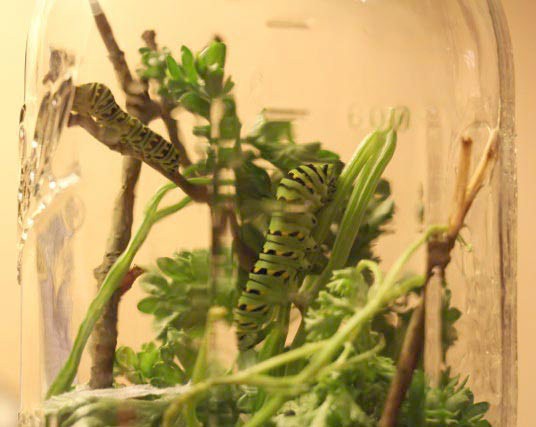I’m holding my daughter up to a jar. It’s a quart jar, initially used for syrup, more recently serving as my improvised coffee-to-go container, and now in its third career as the parsley filled home of three black swallowtail caterpillars. A neighbor brought them to us yesterday. They are remarkably beautiful creatures. They are bright lime green, with black bands and yellow dots. Two are as thick and nearly as long as my pinky fingers. The third is tiny, not long from the egg. It’s so little that its tightly bunched bands make it look like a darker species. It clings to its own parsley frond, as if wary of being gobbled up by the others.
“I want to pet them,” says Lucy. She’s almost three, with all the tactile avarice of that age. All creatures must be touched. So far this summer Lucy has laid hands on cows, horses, red efts, turtles, frogs, ladybugs, spittle bug spit, and the torn leather sacs of hatched turtles. This past weekend, a thrill: she had the opportunity to touch a starfish in an aquarium “toddler tank.”
Caterpillar petting, however, seems like a bad idea. Caterpillar petting seems destined to devolve into caterpillar squashing. Their segmented bodies remind me of rows of bubble wrap bubbles. Lucy loves to pop bubblewrap. So, at least until my daughter is a little less keyed up, and until I’m prepared for a session of intensive chaperoning, the swallowtails stay on the other side of the glass.
According to the Vermont Center for Ecostudies’ (VCE’s) Butterfly Survey, there are at least 103 butterfly and giant silk moth species in my northeastern state alone. Of which, I can identify on the wing all of… 11 (thanks mostly to a story we ran on caterpillar-to-butterfly transformations in 2010).
My daughter’s constant “what’s that?” has been a spur to learn more. Nothing reveals one’s own ignorance as the presence of an inquisitive child.
I was also inspired recently by Kent McFarland, a conservation biologist and co-founder of VCE. Kent was the keynote speaker at the Wellborn Ecology Fund’s annual meeting. At the event, he described a photo quiz he had given middle school students, asking them to identify some of the more common northeastern species. Predictably enough, given kids’ increasing alienation from nature, the quiz results were very poor.
So, along with Lucy, I’m trying to educate myself about common butterflies. Today’s lesson: black swallowtails. Not bold Eastern Tigers, not the Spicebush with their white-flecked rims. Look for a black spot in a larger orange spot on the hindwing. Don’t be fooled by the “distasteful Pipevine swallowtail,” that per the butterfly survey the females somewhat resemble.
“The beginning of wisdom,” said Kent, quoting a Chinese proverb, “is to call things by their right names.”
And the beginning of a nature-savvy child, perhaps, is to know how a caterpillar feels against her skin. Lucy’s looking calmer now, deep in a conversation with our dog. I screw open the jar lid, lift out a swallowtail, and place it gently in her palm.



Discussion *